Downtown Halifax restaurants innovate to earn customer trust
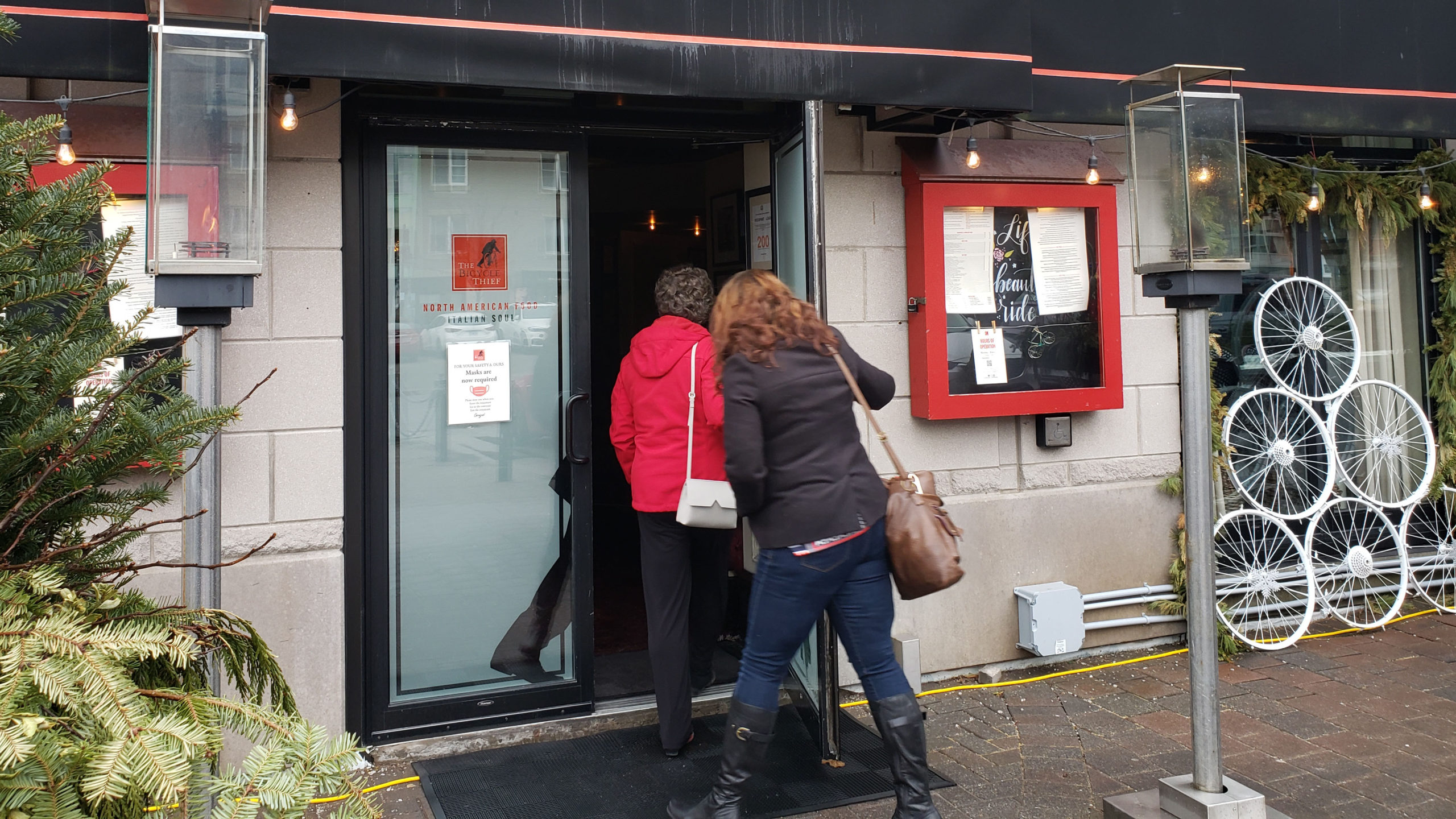
caption
Customers are prompted to text 11011 before entering restaurants for contact-tracingRestaurants are using digital contact tracing technology to ensure diners are safe during COVID
David Shuman is a downtown restaurant patron who recently used the new contact tracing system when visiting the Board Room Game Cafe. As he entered the restaurant he felt a sense of comfort.
“It made me feel a lot safer going in,” says Shuman.
Last summer Shuman had gone to the same cafe and felt “a bit nervous.”
“This time having that added precaution just really got me ready for the visit and put me at ease.”
Shuman says he has been hesitant to go anywhere since last March, and he had only gone to three or so restaurants since the start of the pandemic.
COVID has raged on for nearly a year and Halifax restaurants have been hard hit. One of the issues they face has been customer apprehension about dining in public.
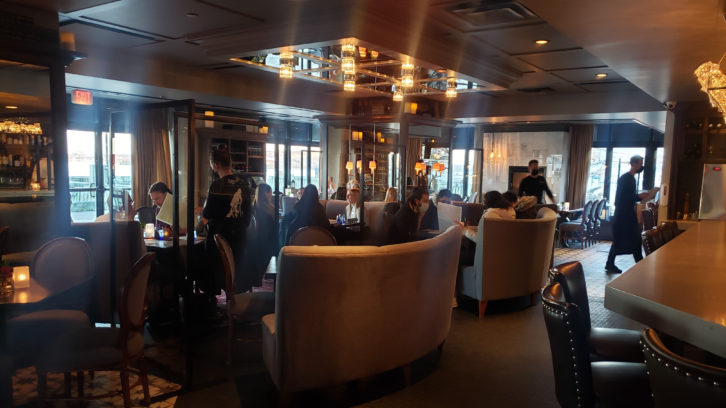
caption
Restaurants such as The Bicycle Thief have taken many approaches to ensure customer safetyAccording to the Restaurant Association of Nova Scotia, sales were down 30 to 50 per cent in 2020 compared to the previous year. Additionally, employment in the restaurant industry saw a decrease of 15,000 employees throughout the province.
Gordon Stewart, executive director of the Restaurant Association of Nova Scotia, says 65 per cent or more of downtown Halifax restaurants are losing money. Downtown businesses are faring worse than their suburban and rural counterparts in Nova Scotia due to their reliance on office workers and visitors.
Stewart says there is virtually no lunch business anymore in Halifax, with offices empty and people working from home. Additionally, conventions, business events, as well as sports and cruise ship visits are all no longer taking place, reducing sales.
Stewart says the issue of customer safety been particularly harmful to the industry.
“COVID itself is cutting into people’s confidence,” says Stewart.
The first time an exposure warning came up last year in a downtown restaurant, business dropped 80 per cent the next night for all eateries in downtown Halifax, says Stewart.
A solution
Back in November the provincial government used the Health Protection Act to make contact tracing mandatory for all Nova Scotia restaurants. This was done at the request of the restaurant association.
“This is critical to keeping restaurants open,” says Stewart.
The contact tracing system is relatively simple. Customers are given a restaurant code (usually the name of the place) that they text to 11011 with their name. They immediately receive a verification and are good to go.
Restaurants had been asking customers to write down their name and phone number in the event of an exposure, so they could be contacted. The new approach speeds up the process for restaurants and shifts the burden of storing the information from restaurants to the system’s developer, says Stewart.
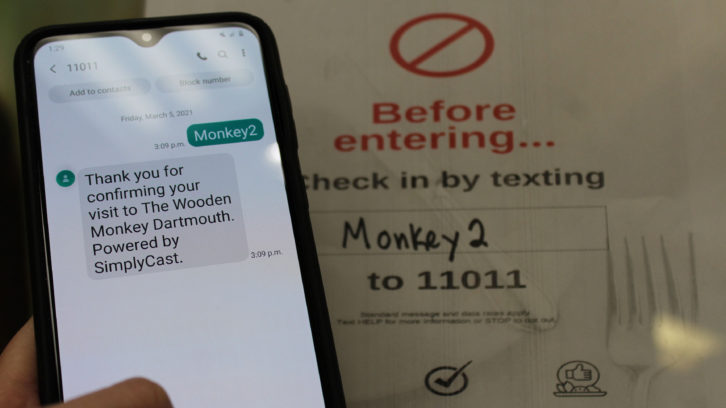
caption
Information received through customer texts are stored with the developer SimplyCastIf customers do not have a phone, they can simply input their information manually using the restaurant’s computer or tablet. Nine out of ten check-ins are done by phone, says Stewart.
Many Halifax restaurants have adopted this method of contact tracing and in February alone 68,000 people were checked in using the system, says Stewart.
Stewart says the association has received no complaints.
“Which is surprising, because normally you can’t do anything without complaints.”
The developer
The system was developed by a local communication software company, SimplyCast, which specializes in engagement technology and its software supports many universities, governments, banks and small businesses.
The company won the bidding process launched by the restaurant association and received funding from the Department of Inclusive Economic Growth (then the Department of Business).
“We were the only bidders of about three or four that proposed a non-downloadable option,” says Saeed El-Darahali, president and chief executive officer of the company.
The other companies had proposed apps that would be downloaded by restaurant patrons, much like the COVID alert app rolled out by the federal government. El-Darahali says SimplyCast’s system is easier and more straightforward than an app-based approach and it is running pilot programs in Prince Edward Island and New Brunswick
The system is a derivative of a solution SimplyCast designed back in 2013 for public transit but was never finished and rolled out, says El-Darahali.
El-Darahali says the system gives public health officials access to a database where people have consented to giving their name and number as well as the time they visited a restaurant, in case an exposure were to take place. If an exposure is discovered, public health can simply query the timeframe and see all the patrons who may have been exposed.
“It’s one more way customers can feel safer,” says Gordon Stewart.
The system in action
For the restaurants, things have been going relatively well with the system’s rollout.
Laura Kirkpatrick is communications and events coordinator of the Bertossi Group, an organization of restaurants that includes The Bicycle Thief, Ristorante a Mano, La Frasca and il Mercato Trattoria in Bedford. The four restaurants adopted the system at the end of January.
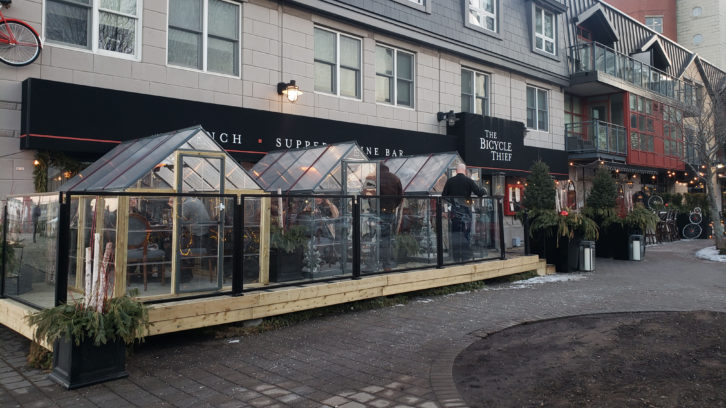
caption
Some restaurants provide private dining shelters as an alternative during COVID“This is a much better way to keep track of guests,” she says. “Our customers find it much easier than the paper method.”
Customers can have their phones ready and easily text the number, and some who have already visited may do so as they arrive, speeding up seating, says Kirkpatrick.
“If there’s an exposure it is all on Public Health to do the actual contact tracing, we don’t have to do anything.”
Patrick Gaetz, the general manager of Ristorante a Mano, says that sometimes older guests have problems accessing the system but generally the process is easier.
“Overall, it’s great and a better system than the paper method.”
Privacy concerns
Kate Evely visited The Bicycle Thief a few weeks ago and found the system “very easy to use and (it) felt very safe.”
She says the fact that it is digital and not an app is helpful since it takes the burden off customers to have the software on their phones. And she’s more likely to dine out because of innovations such as this.
However, she noted that customers may be concerned that their information is being sent to a database where it can be accessed by others. She recently went to Hermitage on Lower Water Street as well as The Bicycle Thief.
“They both used the 11011 number, I’m not sure if they are connected by a parent company but it does make you question where is that phone number going and what database does that go to and who has access to it?” says Evely.
Saeed El-Darahali says that customers have nothing to worry about.
“It keeps the information private and keeps the information from being misused for any other purpose,” Saeed El-Darahali
The information is stored with SimplyCast in their own Canadian database and can only be accessed by Public Health if there is an exposure. Otherwise, the information is encrypted and protected, says El-Darahali.
“There is no movement tracking whatsoever.”
Other innovations
David Shuman says knowing in advance whether a restaurant is crowded would make him more comfortable when dining out. He suggested a colour-coded system of green, yellow and red indicators to show how busy the location is. He says he’s gone to restaurants where there was crowding and felt uneasy.
This is similar to technology already in use by transit apps such as the one used by Halifax Transit. This app is downloaded onto the user’s phone and while taking the bus, users can report whether a bus is crowded using their touchscreen. Other riders can then see this information.
El-Darahali says this technology is available but was not requested by the restaurant association when designing the contact tracing system.
Additionally, El-Darahali says SimplyCast has the technology to improve the contact tracing system so that if there is an exposure, an automated message can be sent out to all relevant contacts instantly. This is important when exposures are large and phone calls can become excessive and contacts must be reached quickly. This technology is not part of Nova Scotia’s contact tracing system either, says El-Darahali, as it was not requested.
A beleaguered industry
Paul MacKinnon, the chief executive officer of the Downtown Halifax Business Commission, says the contact tracing system is meant to boost confidence in the safety of restaurant dining in pandemic times.
“People are afraid to go out and be in places with other people … going out to eat is one of the easiest things to cut out,” he says. “It just isn’t essential.”
MacKinnon says the restaurant industry in Halifax has been battered throughout the pandemic.
“There is a fear or sense that COVID was being spread through restaurants more often … I don’t think that’s probably even accurate.”
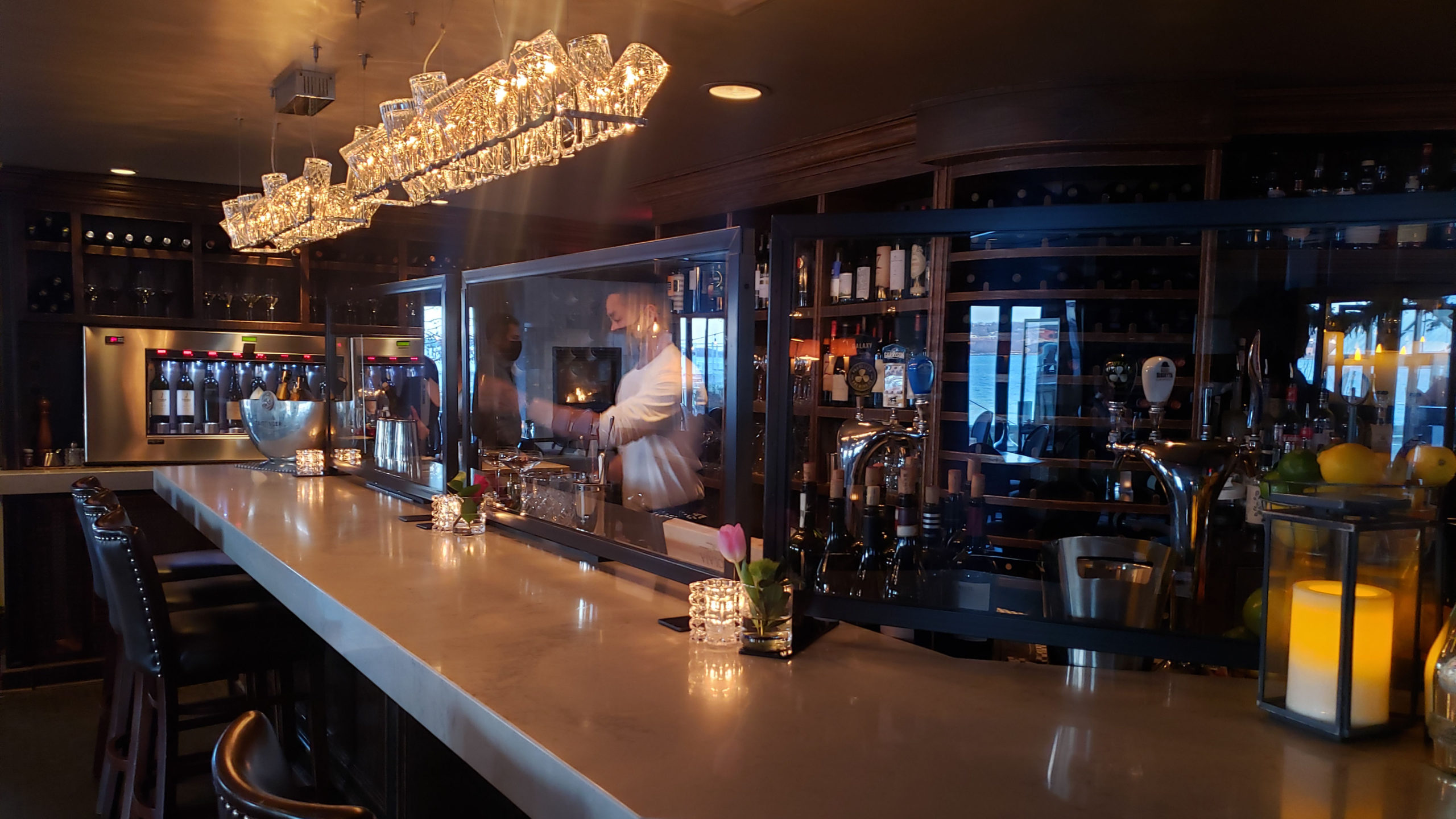
caption
Restaurants were forced to close an hour early last month due to case spikesOther measures restaurants in downtown Halifax have been implementing for customer safety include spacing seats, lowering restaurant capacities, using plastic barriers between tables, testing staff for the virus, building patio shelters for private meals, offering takeout and delivery and even voluntarily closing during COVID case spikes.
Just a few weeks ago the government under new Premier Iain Rankin, in response to an increase in the number of COVID infections, scaled back restaurant closing time from 11 p.m. to 10 p.m. Many restaurants were asking why this was done and whether there was any science or data behind this slight change, says MacKinnon.
“Some restaurants have expressed the concern that it almost feels like public health is blaming them … this doesn’t inspire a lot of confidence in diners.” Gordon Stewart
MacKinnon says that government messaging should do more to strike a balance between safety and supporting the local economy and restaurants.
He believes restaurant have taken an unfair brunt of the messaging around COVID safety and this has had devastating effects on the industry.
“Halifax is defined by our restaurants. The more that shut down the more that impacts our general long-term recovery as a province,” says MacKinnon.
MacKinnon says that with vaccines on the way the next step towards rehabilitating the crippled industry would be attempting to have an interprovincial tourism season this summer. As of March 18 the Council of Atlantic Premiers announced plans to open up an Atlantic travel bubble by April 19.
For now, the industry copes with the reality of the pandemic, doing what it can to convince the hesitant public it’s safe to dine out.
About the author
Nathan Horne
Nathan Horne is a journalist interested in breaking stories that highlight the inequalities and injustices in society.
